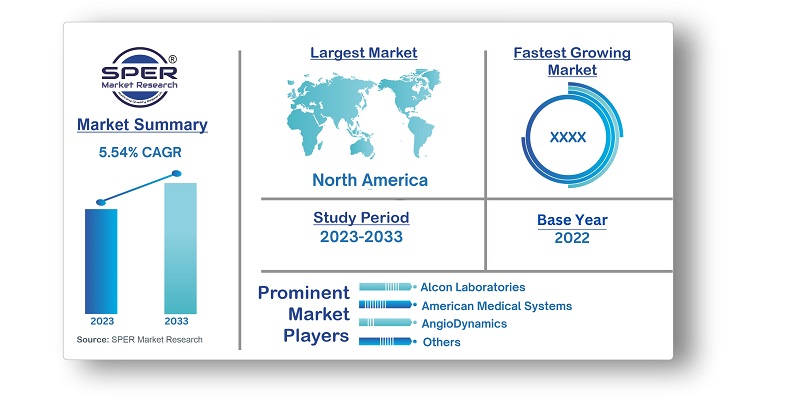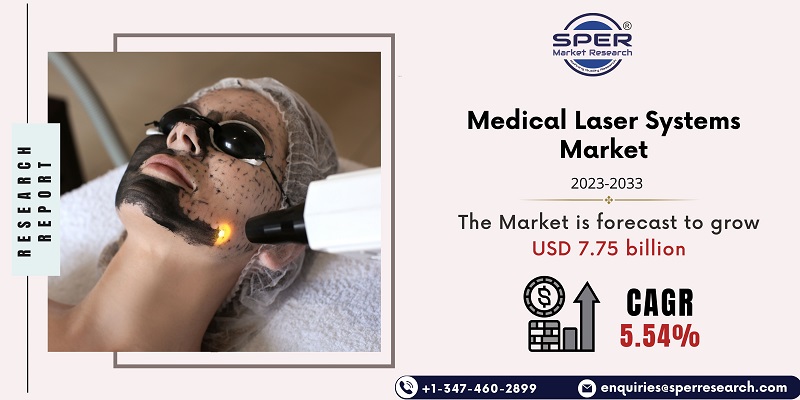
Medical Laser Systems Market Growth, Size, Trends, Revenue, Demand, Share and Future Outlook
Medical Laser Systems Market Size- By Product, By Application- Regional Outlook, Competitive Strategies and Segment Forecast to 2033
| Published: Jan-2024 | Report ID: HLCA2414 | Pages: 1 - 234 | Formats*: |
| Category : Healthcare | |||
- Aesthetics gadget company The medical equipment manufacturer Perigee Medical and Powered by MRP have formed a strategic alliance. Perigee Medical carries the Edge One CO2 fractional laser and is the official distributor for Jeisys Medical in the US and Canada.

- The increasing number of cosmetic processes. It is anticipated that the growing demand for minimally invasive, painless medical procedures will be advantageous to the industry. The numerous campaigns that healthcare organizations run to encourage medical travel also present a chance for market growth. Growing disposable incomes and the need for laser therapy in developing countries will both contribute to market growth in the coming year. There is also opportunity for growth due to the rise of multi-specialty hospitals that provide a wide range of services and payment alternatives.
- Strict safety protocols However, the high failure rate and stringent safety regulations will hinder the market's rate of expansion. The market for medical laser systems will be challenged by emerging economies' lack of healthcare infrastructure and a shortage of qualified personnel.
Highly Expensive The high expense of medical laser services is the reason why fewer clients are selecting these facilities. People from moderate to lower socioeconomic backgrounds cannot afford these kinds of services due to the high cost of the approaches. Strict safety regulations and the high failure rate of laser surgeries limit the market's potential growth.

| Report Metric | Details |
| Market size available for years | 2019-2033 |
| Base year considered | 2022 |
| Forecast period | 2023-2033 |
| Segments covered | By Product, By Application |
| Regions covered | North America, Asia-Pacific, Latin America, Middle East & Africa and Europe |
| Companies Covered | Alcon Laboratories, Inc, American Medical Systems, AngioDynamics, Bausch & Lomb Incorporated, BIOLASE, Inc., Boston Scientific Corporation, CANDELA CORPORATION, CryoLife, Inc, Fujikura Ltd., IRIDEX Corporation, LASOS Lasertechnik GmbH, Lumenis Be Ltd., Modu-Laser, Novadaq Technologies, Inc, Philips Healthcare, Photomedex, Others. |
- Hospitals and Clinics
- Surgeons and Medical Practitioners
- Medical Device Manufacturers
- Distributors and Suppliers
- Research and Academic Institutions
- Regulatory Authorities and Policy Makers
- Investors and Financial Institutions
- Patients and General Public
- Healthcare IT Professionals
| By Product: |
|
| By Application: |
|
| By Region: |
|
- Global Medical Laser Systems Market Size (FY’2023-FY’2033)
- Overview of Global Medical Laser Systems Market
- Segmentation of Global Medical Laser Systems Market By Product (Diode Lasers
- Solid State, Lasers, Gas Lasers, Dye Lasers)
- Segmentation of Global Medical Laser Systems Market By Application (Dermatology, Ophthalmology, Gynecology, Urology, Dentistry, Cardiology, Others)
- Statistical Snap of Global Medical Laser Systems Market
- Expansion Analysis of Global Medical Laser Systems Market
- Problems and Obstacles in Global Medical Laser Systems Market
- Competitive Landscape in the Global Medical Laser Systems Market
- Impact of COVID-19 and Demonetization on Global Medical Laser Systems Market
- Details on Current Investment in Global Medical Laser Systems Market
- Competitive Analysis of Global Medical Laser Systems Market
- Prominent Players in the Global Medical Laser Systems Market
- SWOT Analysis of Global Medical Laser Systems Market
- Global Medical Laser Systems Market Future Outlook and Projections (FY’2023-FY’2033)
- Recommendations from Analyst
1.1. Scope of the report1.2. Market segment analysis
2.1. Research data source2.1.1. Secondary Data2.1.2. Primary Data2.1.3. SPER’s internal database2.1.4. Premium insight from KOL’s2.2. Market size estimation2.2.1. Top-down and Bottom-up approach2.3. Data triangulation
4.1. Driver, Restraint, Opportunity and Challenges analysis4.1.1. Drivers4.1.2. Restraints4.1.3. Opportunities4.1.4. Challenges4.2. COVID-19 Impacts of the Global Medical Laser Systems Market
5.1. SWOT Analysis5.1.1. Strengths5.1.2. Weaknesses5.1.3. Opportunities5.1.4. Threats5.2. PESTEL Analysis5.2.1. Political Landscape5.2.2. Economic Landscape5.2.3. Social Landscape5.2.4. Technological Landscape5.2.5. Environmental Landscape5.2.6. Legal Landscape5.3. PORTER’s Five Forces5.3.1. Bargaining power of suppliers5.3.2. Bargaining power of buyers5.3.3. Threat of Substitute5.3.4. Threat of new entrant5.3.5. Competitive rivalry5.4. Heat Map Analysis
6.1. Global Medical Laser Systems Market Manufacturing Base Distribution, Sales Area, Product Type6.2. Mergers & Acquisitions, Partnerships, Product Launch, and Collaboration in Global Medical Laser Systems Market
7.1. Global Medical Laser Systems Market Value Share and Forecast, By Product, 2023-20337.2. Diode Lasers7.3. Solid State (Crystal) Lasers7.4. Gas Lasers7.5. Dye Lasers
8.1. Global Medical Laser Systems Market Value Share and Forecast, By Application, 2023-20338.2. Dermatology8.3. Ophthalmology8.4. Gynecology8.5. Urology8.6. Dentistry8.7. Cardiology8.8. Others
9.1. Global Medical Laser Systems Market Size and Market Share
10.1. Global Medical Laser Systems Market Size and Market Share By Product (2019-2026)10.2. Global Medical Laser Systems Market Size and Market Share By Produc (2027-2033)
11.1. Global Medical Laser Systems Market Size and Market Share By Application (2019-2026)11.2. Global Medical Laser Systems Market Size and Market Share By Application (2027-2033)
12.1. Global Medical Laser Systems Market Size and Market Share By Region (2019-2026)12.2. Global Medical Laser Systems Market Size and Market Share By Region (2027-2033)12.3. Asia-Pacific12.3.1. Australia12.3.2. China12.3.3. India12.3.4. Japan12.3.5. South Korea12.3.6. Rest of Asia-Pacific
12.4. Europe
12.4.1. France12.4.2. Germany12.4.3. Italy12.4.4. Spain12.4.5. United Kingdom12.4.6. Rest of Europe12.5. Middle East and Africa12.5.1. Kingdom of Saudi Arabia12.5.2. United Arab Emirates12.5.3. Rest of Middle East & Africa12.6. North America12.6.1. Canada12.6.2. Mexico12.6.3. United States12.7. Latin America12.7.1. Argentina12.7.2. Brazil12.7.3. Rest of Latin America
13.1. Alcon Laboratories, Inc13.1.1. Company details13.1.2. Financial outlook13.1.3. Product summary13.1.4. Recent developments13.2. American Medical Systems13.2.1. Company details13.2.2. Financial outlook13.2.3. Product summary13.2.4. Recent developments13.3. AngioDynamics13.3.1. Company details13.3.2. Financial outlook13.3.3. Product summary13.3.4. Recent developments13.4. Bausch & Lomb Incorporated13.4.1. Company details13.4.2. Financial outlook13.4.3. Product summary13.4.4. Recent developments13.5. BIOLASE, Inc.13.5.1. Company details13.5.2. Financial outlook13.5.3. Product summary13.5.4. Recent developments13.6. Boston Scientific Corporation13.6.1. Company details13.6.2. Financial outlook13.6.3. Product summary13.6.4. Recent developments13.7. CANDELA CORPORATION13.7.1. Company details13.7.2. Financial outlook13.7.3. Product summary13.7.4. Recent developments13.8. CryoLife, Inc13.8.1. Company details13.8.2. Financial outlook13.8.3. Product summary13.8.4. Recent developments13.9. Fujikura Ltd.13.9.1. Company details13.9.2. Financial outlook13.9.3. Product summary13.9.4. Recent developments13.10. IRIDEX Corporation13.10.1. Company details13.10.2. Financial outlook13.10.3. Product summary13.10.4. Recent developments13.11. LASOS Lasertechnik GmbH13.11.1. Company details13.11.2. Financial outlook13.11.3. Product summary13.11.4. Recent developments13.12. Lumenis Be Ltd.13.12.1. Company details13.12.2. Financial outlook13.12.3. Product summary13.12.4. Recent developments13.13. Modu-Laser13.13.1. Company details13.13.2. Financial outlook13.13.3. Product summary13.13.4. Recent developments13.14. Novadaq Technologies, Inc13.14.1. Company details13.14.2. Financial outlook13.14.3. Product summary13.14.4. Recent developments13.15. Philips Healthcare13.15.1. Company details13.15.2. Financial outlook13.15.3. Product summary13.15.4. Recent developments13.16. Photomedex13.16.1. Company details13.16.2. Financial outlook13.16.3. Product summary13.16.4. Recent developments13.17. Others
SPER Market Research’s methodology uses great emphasis on primary research to ensure that the market intelligence insights are up to date, reliable and accurate. Primary interviews are done with players involved in each phase of a supply chain to analyze the market forecasting. The secondary research method is used to help you fully understand how the future markets and the spending patterns look likes.
The report is based on in-depth qualitative and quantitative analysis of the Product Market. The quantitative analysis involves the application of various projection and sampling techniques. The qualitative analysis involves primary interviews, surveys, and vendor briefings. The data gathered as a result of these processes are validated through experts opinion. Our research methodology entails an ideal mixture of primary and secondary initiatives.



Frequently Asked Questions About This Report
PLACE AN ORDER
Year End Discount
Sample Report
Pre-Purchase Inquiry
NEED CUSTOMIZATION?
Request CustomizationCALL OR EMAIL US
100% Secure Payment






Related Reports
Our Global Clients
Our data-driven insights have influenced the strategy of 200+ reputed companies across the globe.




















